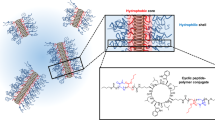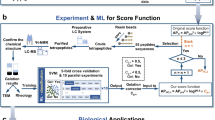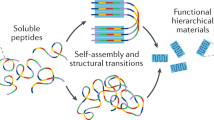Abstract
Peptides that self-assemble into nanostructures are of tremendous interest for biological, medical, photonic and nanotechnological applications. The enormous sequence space that is available from 20 amino acids probably harbours many interesting candidates, but it is currently not possible to predict supramolecular behaviour from sequence alone. Here, we demonstrate computational tools to screen for the aqueous self-assembly propensity in all of the 8,000 possible tripeptides and evaluate these by comparison with known examples. We applied filters to select for candidates that simultaneously optimize the apparently contradicting requirements of aggregation propensity and hydrophilicity, which resulted in a set of design rules for self-assembling sequences. A number of peptides were subsequently synthesized and characterized, including the first reported tripeptides that are able to form a hydrogel at neutral pH. These tools, which enable the peptide sequence space to be searched for supramolecular properties, enable minimalistic peptide nanotechnology to deliver on its promise.
This is a preview of subscription content, access via your institution
Access options
Subscribe to this journal
Receive 12 print issues and online access
$259.00 per year
only $21.58 per issue
Buy this article
- Purchase on Springer Link
- Instant access to full article PDF
Prices may be subject to local taxes which are calculated during checkout



Similar content being viewed by others
References
Zhao, X. et al. Molecular self-assembly and applications of designer peptide amphiphiles. Chem. Soc. Rev. 39, 3480–3498 (2010).
Zelzer, M. & Ulijn, R. V. Next-generation peptide nanomaterials: molecular networks, interfaces and supramolecular functionality. Chem. Soc. Rev. 39, 3351–3357 (2010).
Reches, M. & Gazit, E. Casting metal nanowires within discrete self-assembled peptide nanotubes. Science 300, 625–627 (2003).
Ghadiri, M. R., Granja, J. R., Milligan, R. A., McRee, D. E. & Khazanovich, N. Self-assembling organic nanotubes based on a cyclic peptide architecture. Nature 366, 324–327 (1993).
Zhang, S., Holmes, T., Lockshin, C. & Rich, A. Spontaneous assembly of a self-complementary oligopeptide to form a stable macroscopic membrane. Proc. Natl Acad. Sci. USA 90, 3334–3338 (1993).
Reches, M. & Gazit, E. Formation of closed-cage nanostructures by self-assembly of aromatic dipeptides. Nano Lett. 4, 581–585 (2004).
Tamamis, P. et al. Self-assembly of phenylalanine oligopeptides: insights from experiments and simulations. Biophys. J. 96, 5020–5029 (2009).
Moitra, P., Kumar, K., Kondaiah, P. & Bhattacharya, S. Efficacious anticancer drug delivery mediated by a pH-sensitive self-assembly of a conserved tripeptide derived from tyrosine kinase NGF receptor. Angew. Chem. Int. Ed. 53, 1113–1117 (2014).
Marchesan, S., Easton, C. D., Kushkaki, F., Waddington, L. & Hartley, P. G. Tripeptide self-assembled hydrogels: unexpected twists of chirality. Chem. Commun. 48, 2195–2197 (2012).
Marchesan, S. et al. Unzipping the role of chirality in nanoscale self-assembly of tripeptide hydrogels. Nanoscale 4, 6752–6760 (2012).
Marchesan, S. et al. Chirality effects at each amino acid position on tripeptide self-assembly into hydrogel biomaterials. Nanoscale 6, 5172–5180 (2014).
James, J. & Mandal, A. B. The aggregation of Tyr-Phe dipeptide and Val-Tyr-Val tripeptide in aqueous solution and in the presence of SDS and PEO–PPO–PEO triblock copolymer: fluorescence spectroscopic studies. J. Colloid Interface Sci. 360, 600–605 (2011).
Reches, M., Porat, Y. & Gazit, E. Amyloid fibril formation by pentapeptide and tetrapeptide fragments of human calcitonin. J. Biol. Chem. 277, 35475–35480 (2002).
Hauser, C. A. E. et al. Natural tri- to hexapeptides self-assemble in water to amyloid beta-type fiber aggregates by unexpected alpha-helical intermediate structures. Proc. Natl Acad. Sci. USA 108, 1361–1366 (2011).
Lakshmanan, A. & Hauser, C. A. E. Ultrasmall peptides self-assemble into diverse nanostructures: morphological evaluation and potential implications. Int. J. Mol. Sci. 12, 5736–5746 (2011).
Lakshmanan, A. et al. Aliphatic peptides show similar self-assembly to amyloid core sequences, challenging the importance of aromatic interactions in amyloidosis. Proc. Natl Acad. Sci. USA 110, 519–524 (2013).
Cao, M., Cao, C., Zhang, L., Xia, D. & Xu, H. Tuning of peptide assembly through force balance adjustment. J. Colloid Interface Sci. 407, 287–295 (2013).
Smadbeck, J. et al. De novo design and experimental characterization of ultrashort self-associating peptides. PLoS Comput. Biol. 10, e1003718 (2014).
Das, A. K., Bose, P. P., Drew, M. G. B. & Banerjee, A. The role of protecting groups in the formation of organogels through a nano-fibrillar network formed by self-assembling terminally protected tripeptides. Tetrahedron 63, 7432–7442 (2007).
Subbalakshmi, C., Manorama, S. V. & Nagaraj, R. Self-assembly of short peptides composed of only aliphatic amino acids and a combination of aromatic and aliphatic amino acids. J. Pept. Sci. 18, 283–292 (2012).
Fleming, S. & Ulijn, R. V. Design of nanostructures based on aromatic peptide amphiphiles. Chem. Soc. Rev. 43, 8150–8177 (2014).
Zhang, Y., Gu, H., Yang, Z. & Xu, B. Supramolecular hydrogels respond to ligand–receptor interaction. J. Am. Chem. Soc. 125, 13680–13681 (2003).
Yang, Z., Liang, G., Ma, M., Gao, Y. & Xu, B. Conjugates of naphthalene and dipeptides produce molecular hydrogelators with high efficiency of hydrogelation and superhelical nanofibers. J. Mater. Chem. 17, 850–854 (2007).
Chen, L., Revel, S., Morris, K. C., Serpell, L. & Adams, D. J. Effect of molecular structure on the properties of naphthalene–dipeptide hydrogelators. Langmuir 26, 13466–13471 (2010).
DeGrado, W. F. & Lear, J. D. Induction of peptide conformation at apolar water interfaces. 1. A study with model peptides of defined hydrophobic periodicity. J. Am. Chem. Soc. 107, 7684–7689 (1985).
DeGrado, W. F. Design of peptides and proteins. Adv. Protein Chem. 39, 51–124 (1988).
McCullagh, M., Prytkova, T., Tonzani, S., Winter, N. D. & Schatz, G. C. Modeling self-assembly processes driven by nonbonded interactions in soft materials. J. Phys. Chem. B 112, 10388–10398 (2008).
Lee, O-S., Cho, V. & Schatz, G. C. Modeling the self-assembly of peptide amphiphiles into fibers using coarse-grained molecular dynamics. Nano Lett. 12, 4907–4913 (2012).
Frederix, P. W. J. M., Ulijn, R. V., Hunt, N. T. & Tuttle, T. Virtual screening for dipeptide aggregation: toward predictive tools for peptide self-assembly. J. Phys. Chem. Lett. 2, 2380–2384 (2011).
Wu, C., Lei, H. & Duan, Y. Formation of partially ordered oligomers of amyloidogenic hexapeptide (NFGAIL) in aqueous solution observed in molecular dynamics simulations. Biophys. J. 87, 3000–3009 (2004).
Guo, C., Luo, Y., Zhou, R. & Wei, G. Probing the self-assembly mechanism of diphenylalanine-based peptide nanovesicles and nanotubes. ACS Nano 6, 3907–3918 (2012).
Guo, C., Luo, Y., Zhou, R. & Wei, G. Triphenylalanine peptides self-assemble into nanospheres and nanorods that are different from the nanovesicles and nanotubes formed by diphenylalanine peptides. Nanoscale 6, 2800–2811 (2014).
Thirumalai, D., Klimov, D. & Dima, R. Emerging ideas on the molecular basis of protein and peptide aggregation. Curr. Opin. Struct. Biol. 13, 146–159 (2003).
Monticelli, L. et al. The MARTINI coarse-grained force field: extension to proteins. J. Chem. Theory Comput. 4, 819–834 (2008).
Singh, G. & Tieleman, D. P. Using the Wimley–White hydrophobicity scale as a direct quantitative test of force fields: the MARTINI coarse-grained model. J. Chem. Theory Comput. 7, 2316–2324 (2011).
De Jong, D. H., Periole, X. & Marrink, S. J. Dimerization of amino acid side chains: lessons from the comparison of different force fields. J. Chem. Theory Comput. 8, 1003–1014 (2012).
De Jong, D. H. et al. Improved parameters for the Martini coarse-grained protein force field. J. Chem. Theory Comput. 9, 687–697 (2013).
Zaccai, N. R. et al. A de novo peptide hexamer with a mutable channel. Nature Chem. Biol. 7, 935–941 (2011).
White, S. H. & Wimley, W. C. Hydrophobic interactions of peptides with membrane interfaces. Biochim. Biophys. Acta 1376, 339–352 (1998).
Wimley, W. C., Creamer, T. P. & White, S. H. Solvation energies of amino acid side chains and backbone in a family of host–guest pentapeptides. Biochemistry 35, 5109–5124 (1996).
Chiti, F., Stefani, M., Taddei, N., Ramponi, G. & Dobson, C. M. Rationalization of the effects of mutations on peptide andprotein aggregation rates. Nature 424, 805–808 (2003).
Pawar, A. P. et al. Prediction of ‘aggregation-prone’ and ‘aggregation-susceptible’ regions in proteins associated with neurodegenerative diseases. J. Mol. Biol. 350, 379–392 (2005).
West, M. W. et al. De novo amyloid proteins from designed combinatorial libraries. Proc. Natl Acad. Sci. USA 96, 11211–11216 (1999).
Ash, W. L., Zlomislic, M. R., Oloo, E. O. & Tieleman, D. P. Computer simulations of membrane proteins. Biochim. Biophys. Acta 1666, 158–189 (2004).
Yesylevskyy, S. O., Schäfer, L. V., Sengupta, D. & Marrink, S. J. Polarizable water model for the coarse-grained MARTINI force field. PLoS Comput. Biol. 6, e1000810 (2010).
Seo, M., Rauscher, S., Pomès, R. & Tieleman, D. P. Improving internal peptide dynamics in the coarse-grained MARTINI model: toward large-scale simulations of amyloid- and elastin-like peptides. J. Chem. Theory Comput. 8, 1774–1785 (2012).
Lyon, R. P. & Atkins, W. M. Self-assembly and gelation of oxidized glutathione in organic solvents. J. Am. Chem. Soc. 123, 4408–4413 (2001).
Cohen, Y., Avram, L. & Frish, L. Diffusion NMR spectroscopy in supramolecular and combinatorial chemistry: an old parameter—new insights. Angew. Chem. Int. Ed. 44, 520–554 (2005).
Pouget, E. et al. Elucidation of the self-assembly pathway of lanreotide octapeptide into beta-sheet nanotubes: role of two stable intermediates. J. Am. Chem. Soc. 132, 4230–4241 (2010).
Barth, A. & Zscherp, C. What vibrations tell about proteins. Q. Rev. Biophys. 35, 369–430 (2002).
Fleming, S. et al. Assessing the utility of infrared spectroscopy as a structural diagnostic tool for β-sheets in self-assembling aromatic peptide amphiphiles. Langmuir 29, 9510–9515 (2013).
Fuhrmans, M. & Marrink, S-J. A tool for the morphological analysis of mixtures of lipids and water in computer simulations. J. Mol. Model. 17, 1755–1766 (2011).
Georgoulia, P. S. & Glykos, N. M. On the foldability of tryptophan-containing tetra- and pentapeptides: an exhaustive molecular dynamics study. J. Phys. Chem. B 117, 5522–5532 (2013).
Humphrey, W., Dalke, A. & Schulten, K. VMD: visual molecular dynamics. J. Mol. Graph. 14, 33–38 (1996).
Acknowledgements
The authors thank C. Irving for assistance with DOSY NMR spectroscopy and M. Mullin (Glasgow University) for help with TEM. P.W.J.M.F., N.T.H. and R.V.U. acknowledge financial support from the European Research Council (no. 334949: SPRITES-H2). R.V.U. acknowledges funding from the European Research Council under the European Union's Seventh Framework Programme (FP7/2007-2013)/EMERgE/ERC grant agreement no. 258775. G.G.S. acknowledges financial support by Macphie of Glenbervie. C.G.P. acknowledges financial support by Linn Products. Y.M.A. acknowledges financial support by FP7 Marie Curie Actions of the European Commission, via the initial training network ReAd (no. 289723). Results were obtained using the EPSRC-funded ARCHIE-WeSt High Performance Computer (www.archie-west.ac.uk; EPSRC grant no. EP/K000586/1).
Author information
Authors and Affiliations
Contributions
P.W.J.M.F. was responsible for computational work and infrared spectroscopy. Y.M.A., D.K., C.G.P. and G.G.S. performed peptide synthesis and characterization. N.J., Y.M.A. and G.G.S. performed TEM. C.G.P. performed DOSY NMR spectroscopy. N.J. and D.K. performed DLS. N.T.H., R.V.U. and T.T. contributed to the experimental design. All authors commented on the manuscript. P.W.J.M.F., R.V.U. and T.T. wrote the paper.
Corresponding authors
Ethics declarations
Competing interests
The University of Strathclyde has filed a patent application (UK Patent application no. 1417885.9) on technology related to the processes described in this article. Several authors are listed as inventors on the patent application.
Supplementary information
Supplementary information
Supplementary information (PDF 21900 kb)
Rights and permissions
About this article
Cite this article
Frederix, P., Scott, G., Abul-Haija, Y. et al. Exploring the sequence space for (tri-)peptide self-assembly to design and discover new hydrogels. Nature Chem 7, 30–37 (2015). https://doi.org/10.1038/nchem.2122
Received:
Accepted:
Published:
Issue Date:
DOI: https://doi.org/10.1038/nchem.2122
This article is cited by
-
Molecular dynamics simulations as a guide for modulating small molecule aggregation
Journal of Computer-Aided Molecular Design (2024)
-
Nanofibrous polypeptide hydrogels with collagen-like structure as biomimetic extracellular matrix
Collagen and Leather (2023)
-
Data-mining unveils structure–property–activity correlation of viral infectivity enhancing self-assembling peptides
Nature Communications (2023)
-
Dual enzyme-powered chemotactic cross β amyloid based functional nanomotors
Nature Communications (2023)
-
Accelerating the prediction and discovery of peptide hydrogels with human-in-the-loop
Nature Communications (2023)



